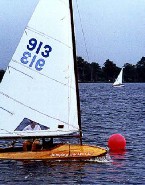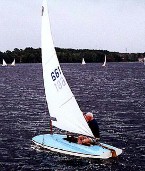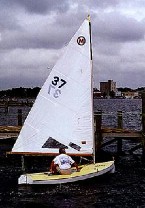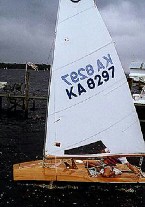 |
 |
 |
 |
 |
 |
 |
 |
Over the years various "Moth" classes have appeared around the world. In addition to the Classic Moth, one can find reference to Australian Moth", "British Moth", and "International Moth". All have eleven foot hulls, and all can trace their origins to either the US or Australian Moth (or both!). Regrettably, unreconciled rule differences, principally in the size of the rig and whether or not hiking wings are permitted prevent the various species" of Moth from competing together.
The Classic US Moth Boat was raced in the United States from 1930 until the late 1960s. The class was formally organized in 1932 as the "National Moth Boat Association". In 1935, due to increasing overseas interest in the class, the name was changed to "International Moth Class Association" or IMCA.
In 1928 Australian sailors also organized an eleven foot development class. At first these Australian boats were known as the "Interloch" class" In 1933, an American magazine, The Rudder, published an article dealing with the Moth Boat scene in US. The Australians noted the similarities between the two groups of boats and intuitively realized that the name "Moth Boat" rolled more easily from the tongue than "Interlock Class", and changed the name of their class to Moth. The Australians also noted the differences, particularly in sail plan between the two boats, but since this was in the middle of the great depression, and the two groups were 13,000 miles apart, no attempt was made to rationalize these differences. Thus two large Moth classes developed separately for the better part of 40 years.
Also, in the early 1930s a small group of sailors in Great Britain formed a "British Moth Class". The British class was restricted to the hull shape of a 1930s Vintage American Moth Boat, and is thus not a development class.
In the 1960s, the Australian Mothists began campaigning for rules changes that would permit the Australian Moths to compete in the IMCA's "World Championships". In 1971 the US based IMCA completed a phase-in of new rules which attempted a "marriage" of the IMCA and the Australian Moth. This amalgamation process had started at the annual IMCA meeting in 1965. New rules embraced the more powerful high aspect, loose footed, fully battened rig of the Australian Moth. The new rules also permitted controversial hiking wings first seen on Moths from Switzerland. Finally, the rule change abolished the US centralized organization of the class in favor of an independent world body with equal-partner national associations. Each national association elected its own officers and world body representatives. The reality of this reorganization was that the US gave away control of the class that they had originated.
The effects of these rule changes in American were two fold: Moths instantly became faster but much more demanding to sail. Although the increased performance was great for the seasoned racers, it effectively discouraged younger, beginning sailors from entering the class.
Another effect adopting the Australian rig and European hiking wings was that boat development increased at revolutionary rather than evolutionary rates at a time when most sailors were buying rather than building their boats. A common remark at that time was that "in order to win, one had to join the boat of the month club".
At about the same time, the Laser class boat appeared. The Laser was a strict one design class and was considerably easier to sail than the high performance "Australian rigged Moth. The handwriting was on the wall. In the course of a few years, the Moth in the US went from a class, which in its heyday could routinely muster 70 boats on the starting line of a typical weekend invitational regatta, to a class which could not draw the minimum number of boats (4) to qualify for a start! It wasn't long before the Moth Boat was dropped by east coast U. S. Yacht Clubs in favor of the Laser. Although small numbers of the high aspect rigged IMCA Moths continue to this day to race in Europe and Australia, by 1978 the U. S. branch of the IMCA was dead.
At this time, Classic Moth Boats race in several locations on the east coast of the US. Regattas are currently held in Brigantine, NJ; Portsmouth, VA; Norfolk, VA; Elizabeth City, NC; and Charleston, SC. In addition, a new regatta is being planned for St. Petersburg, FL in February of 1998. Please refer to the regatta schedule in this site for dates and contact information.
